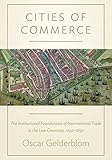Cities of Commerce : The Institutional Foundations of International Trade in the Low Countries, 1250-1650 / Oscar Gelderblom.
Material type: TextSeries: The Princeton Economic History of the Western World ; 45Publisher: Princeton, NJ : Princeton University Press, [2013]Copyright date: ©2013Edition: Course BookDescription: 1 online resource (312 p.)Content type:
TextSeries: The Princeton Economic History of the Western World ; 45Publisher: Princeton, NJ : Princeton University Press, [2013]Copyright date: ©2013Edition: Course BookDescription: 1 online resource (312 p.)Content type: - 9780691142883
- 9781400848591
- BUSINESS & ECONOMICS / Economic History
- Amsterdam
- Antwerp
- Bruges
- Dutch Republic
- Dutch Revolt
- Europe
- European commerce
- Flemish Revolt
- German Hanse
- Habsburgs
- Hans Thijs
- Low Countries
- amicable settlement
- arbitration
- boycotts
- brokers
- central courts
- collective action
- commenda
- commerce
- commercial cities
- commercial infrastructure
- commercial litigation
- commission trade
- compensation
- conflict resolution
- court proceedings
- cross-border trade
- double-entry bookkeeping
- footloose merchants
- foreign traders
- hostellers
- inclusive institutions
- institutional change
- international trade
- losses
- merchants
- open access institutions
- private order solutions
- spot markets
- spreading of risks
- state formation
- trade ports
- urban autonomy
- urban competition
- urban magistrates
- violence
- 382.09492 23
- HF3595 .G45 2017
- online - DeGruyter
- Issued also in print.
| Item type | Current library | Call number | URL | Status | Notes | Barcode | |
|---|---|---|---|---|---|---|---|
 eBook
eBook
|
Biblioteca "Angelicum" Pont. Univ. S.Tommaso d'Aquino Nuvola online | online - DeGruyter (Browse shelf(Opens below)) | Online access | Not for loan (Accesso limitato) | Accesso per gli utenti autorizzati / Access for authorized users | (dgr)9781400848591 |
Frontmatter -- Contents -- Illustrations -- Acknowledgments -- Chapter 1 Introduction -- Chapter 2. Commercial Cities -- Chapter 3. The Organization of Exchange -- Chapter 4. Crossing Borders -- Chapter 5. Conflict Resolution -- Chapter 6. The Protection of Trade -- Chapter 7. Dealing with Losses -- Chapter 8. Conclusion -- Appendix A. The Incidence of Violence against Foreign Merchants in the Low Countries, 1250-1650 -- Appendix B. The Motivation, Organization, and Outcome of Collective Action by Merchants of the German Hanse in Bruges, 1250-1500 -- List of Abbreviations -- Bibliography -- Index
restricted access online access with authorization star
http://purl.org/coar/access_right/c_16ec
Cities of Commerce develops a model of institutional change in European commerce based on urban rivalry. Cities continuously competed with each other by adapting commercial, legal, and financial institutions to the evolving needs of merchants. Oscar Gelderblom traces the successive rise of Bruges, Antwerp, and Amsterdam to commercial primacy between 1250 and 1650, showing how dominant cities feared being displaced by challengers while lesser cities sought to keep up by cultivating policies favorable to trade. He argues that it was this competitive urban network that promoted open-access institutions in the Low Countries, and emphasizes the central role played by the urban power holders--the magistrates--in fostering these inclusive institutional arrangements. Gelderblom describes how the city fathers resisted the predatory or reckless actions of their territorial rulers, and how their nonrestrictive approach to commercial life succeeded in attracting merchants from all over Europe. Cities of Commerce intervenes in an important debate on the growth of trade in Europe before the Industrial Revolution. Challenging influential theories that attribute this commercial expansion to the political strength of merchants, this book demonstrates how urban rivalry fostered the creation of open-access institutions in international trade.
Issued also in print.
Mode of access: Internet via World Wide Web.
In English.
Description based on online resource; title from PDF title page (publisher's Web site, viewed 30. Aug 2021)


